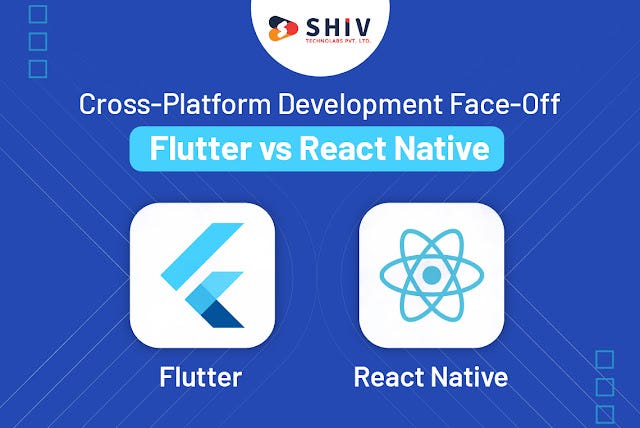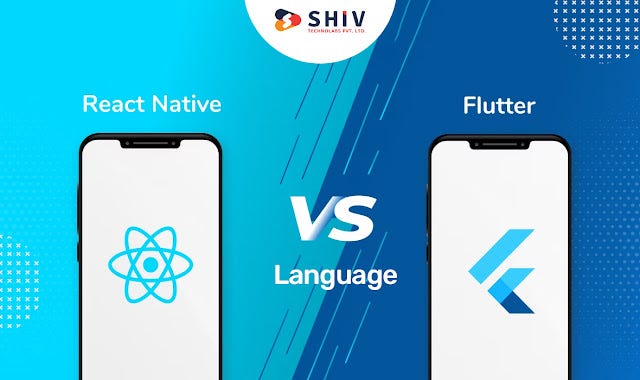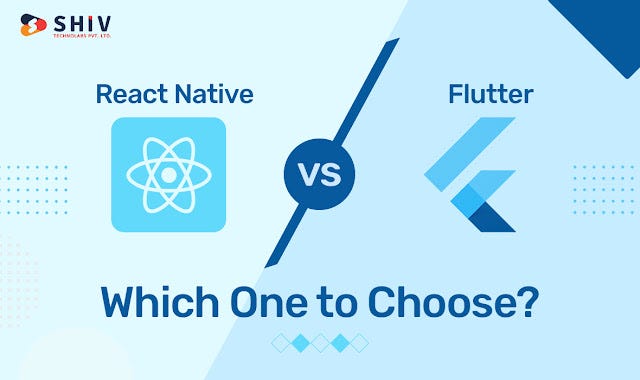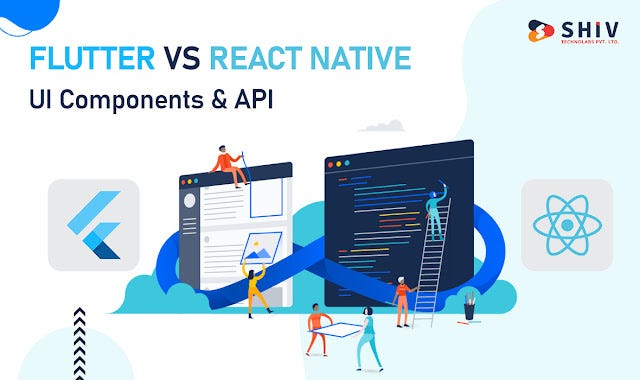
In the realm of mobile app development, one question echoes in the corridors of every tech startup, digital agency, and enterprise-level IT department: “Flutter or React Native?” The quest for the ultimate cross-platform development framework has seen these two giants battle it out for supremacy.
Both supported by industry titans — Flutter by Google and React Native by Facebook — these frameworks offer a robust platform to build attractive, high-performance applications for iOS, Android, and beyond.
As per the latest Statista survey, 32% of developers employ React Native, while 46% use Flutter. Whether you are a business owner wanting to make an informed choice for your next project, or a developer looking to expand your skill set in the most lucrative direction. This blog will help you understand the differences between Flutter and React Native
Pros and Cons of Flutter and React Native Apps
Pros: Flutter
- Performance: Flutter offers high-performance applications because Dart, the underlying language of Flutter, compiles directly into native machine code without the need for a JavaScript bridge.
- Consistent UI across platforms: Flutter provides a consistent, customizable UI experience across all platforms, thanks to its comprehensive set of widgets following Material Design and Cupertino guidelines.
- Hot Reload: This feature enables developers to instantly see changes made in the code on simulators, hardware, or emulators, which aids in quicker bug fixes and faster app development.
- Strong Corporate Support: Google actively supports and promotes Flutter, indicating a promising future for this framework.
Cons: Flutter
- Dart Language: Dart is not as common as JavaScript. Therefore, developers may experience a learning curve when starting with Flutter.
- Larger App Size: Flutter apps can be larger than native or React Native apps, potentially causing longer download times and taking up more storage space on devices.
- Community Size: Being a relatively newer framework, Flutter has a smaller community than React Native. Consequently, there might be fewer resources and third-party libraries available.
Pros: React Native
- JavaScript: React Native is based on JavaScript, a language known by many developers. This makes React Native a more approachable framework for most developers.
- Large Community: React Native, being in the market for a longer time, has a larger community, translating to more third-party libraries, resources, and support.
- Hot Reload: Like Flutter, React Native also offers the hot reload feature, which increases development speed by reflecting code changes in real time.
- Use of Native Components: React Native uses native components for UI, providing an experience close to native applications.
Cons: React Native
- Performance: React Native might not perform as efficiently as Flutter due to the JavaScript bridge used for initiating interactions with native components.
- Requires Native Code: For some features and optimizations, you need to write native code in React Native, which can increase complexity and require separate codebases for different platforms.
- Less Consistent UI: React Native relies on native components for UI. While this gives a more “native” feel, it could lead to inconsistencies in UI across different platforms.

Flutter vs React Native: Performance Analysis
- When we speak about flutter vs react native performance in mobile application development, we generally refer to the speed and responsiveness of the application. This includes the time taken to load, the smoothness of scrolling, and the absence of any form of lag in the interaction.
- In the case of Flutter, the performance is considerably high. The key reason behind this is Flutter’s use of Dart, which gets compiled into native code.
- Flutter doesn’t require a JavaScript bridge, a feature used by React Native to interact with native components, and hence minimizes performance issues. Dart achieves this by compiling ahead of time (AOT) into native, ARM, and x86 libraries, which leads to a faster startup, consistent performance at runtime, and fewer performance ‘jitters’.
- React Native, on the other hand, while quite efficient, may lag behind Flutter slightly when it comes to performance. The reason is its use of the JavaScript bridge for initiating interactions with native components, which can cause inefficiencies and slower performance. However, the actual performance of React Native depends a lot on the efficiency of the third-party libraries being used.
Flutter vs React Native: Popularity
- The flutter vs react native popularity is a measure of how widely adopted technology is among developers. The Stack Overflow Developer Survey found that Flutter had an adoption rate of 12.64%, while React Native was at 12.57%.
- The close numbers show that the competition is close to a tie. While yet in its early stages, Flutter has already attracted support from major companies like Google Ads, Alibaba, and Reflectly. The robust UI capabilities and superb performance of Flutter have contributed to its meteoric surge in popularity.
Flutter vs React Native: Google Trends Analysis
- Google Trends is a trustworthy resource for tracking the growth (or decline) of specific search terms over time. The react native vs flutter Google trends data offers some enlightening statistics.
- Over the past five years, React Native has maintained a progressively greater level of interest than Flutter. However, Flutter’s interest score has been steadily increasing since its inception, thus the difference between the two has been narrowing.
- It’s also interesting to see how widely used these frameworks are across the world. In places like China, South Korea, and the United States, people are particularly interested in finding out more about React Native. On the other hand, countries like India, Brazil, and Russia have seen massive adoption of Flutter.
Flutter vs React Native: Language
- JavaScript is one of the most popular programming languages with a massive developer community. React Native’s usage of JavaScript makes it an attractive choice for developers with web development experience.
- On the other hand, Dart, although powerful and easy to learn, is not as popular as JavaScript. However, Google’s backing and continuous improvements have led to an increasing number of developers choosing Dart and, consequently, Flutter.
Flutter vs React Native: Development Time
- React Native holds an advantage in development time due to its “hot reloading” feature, which allows developers to inject new versions of files edited at runtime, thus keeping the app running and retaining its state.
- Flutter also supports hot reload, but the time taken for testing, UI, and logic development is slightly more than React Native, owing to Dart’s less popularity and limited resources compared to JavaScript.
Flutter vs React Native: UI Components & API
- In terms of UI components and access to native APIs, both Flutter and React Native offer a good deal.
- Flutter provides a rich set of proprietary widgets that look and feel great. It uses the Material Design and Cupertino widgets to mimic the native look of Android and iOS apps.
- React Native, however, relies heavily on third-party libraries as it offers only basic UI rendering and device access APIs. Despite this, due to its more extended existence, it has a larger ecosystem of third-party plugins and libraries that developers can leverage.
Flutter vs React Native: Community and Learning Curve
- The community size of a framework is essential as it leads to more resources for learning and problem-solving. A larger community often equates to more third-party libraries and tools available for developers.
- React Native, due to its earlier inception, has a larger community and better support compared to Flutter. This robust community translates to better resources for learning, solving problems, and coding libraries. The usage of JavaScript, a language most developers are familiar with, also makes the learning curve for React Native relatively less steep.
- Flutter, while newer, has been gaining a robust community. Over 2 million developers have already used Flutter, and 500,000 use it every month. Its documentation is exhaustive and well-structured, which is a significant plus for developers. Although Dart is not as popular as JavaScript, it is easy to grasp, especially for developers experienced with object-oriented programming languages.

Flutter vs React Native: Which One to Choose?
- Team’s Programming Knowledge
The programming language of the framework plays a significant role in the decision-making process. If your team is well-versed in JavaScript, React Native could be a more natural choice due to the familiarity and ease of use. On the other hand, if your team is open to learning Dart, a statically typed language that’s relatively easy to grasp, Flutter can offer unique advantages.
- App Performance
When it comes to performance, Flutter edges out due to its unique architecture. Flutter compiles Dart code into native machine code, which eliminates the JavaScript bridge, thus ensuring smoother and faster performance. However, in most regular use cases, the performance difference between the two frameworks may not be noticeable to end users.
- User Interface
If creating a customized and attractive UI/UX is a significant focus for your app, Flutter offers a rich set of proprietary widgets that adhere to the design languages of both Android (Material Design) and iOS (Cupertino), making it an appealing choice. Conversely, React Native uses native components for UI, meaning it relies on third-party libraries for customization, making the process a bit more complex.
- Development Time and Cost
If you’re working within tight timelines or budget constraints, React Native might be a more suitable choice. Given the widespread use and familiarity of JavaScript, and the abundance of third-party libraries and resources, development in React Native could be quicker and more cost-effective. However, Flutter’s single codebase and widget library can also speed up the development process once the team gets familiar with Dart.
- Long-term Perspective
It’s also important to consider the organizations backing these frameworks and their future plans. Google is pushing Flutter as a universal framework for all screens (mobile, web, and desktop), indicating a solid future roadmap. Facebook, on the other hand, continues to invest in React Native, suggesting consistent growth and enhancements for this framework too.
- Community and Learning Resources
If the size of the community and the availability of learning resources is a priority for you, React Native, due to its long presence in the market, has a more substantial community and a larger set of resources. However, Flutter’s community is growing rapidly, and given Google’s support, it’s likely to flourish.
- Specific Project Requirements
Lastly, the nature of the project itself is a crucial determinant. For instance, if you’re developing an IoT app where performance is the key, Flutter might be the better choice. But, if you’re building a social media app where quick development and deployment matter more, React Native’s JavaScript-based environment might offer more speed and efficiency.

Bottom Line
Cross-platform development has evolved from a mere concept to a powerful reality, revolutionizing how we think about mobile app development. The goal is not to pick the ‘best’ framework but to choose the one that best suits your needs and brings your app vision to life. Whether you go with Flutter or React Native, each has the potential to help you create an amazing cross-platform app.

No comments yet